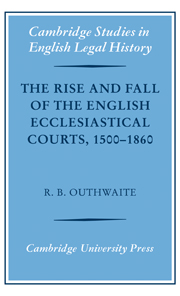Book contents
- Frontmatter
- Contents
- Foreword by R. H. Helmholz
- Preface
- Table of parliamentary statutes
- List of abbreviations
- 1 The ecclesiastical courts: structures and procedures
- 2 The business of the courts, 1500–1640
- 3 Tithe causes
- 4 Wills and testamentary causes
- 5 Defamation suits
- 6 Marital suits and marriage licences
- 7 Office causes
- 8 The roots of expansion and critical voices
- 9 Charting decline, 1640–1830
- 10 Explaining decline
- 11 The bills of 1733–1734
- 12 Snips and repairs: small steps to reform, 1753–1813
- 13 Royal commissions and early fruits, 1815–1832
- 14 Reform frustrated
- 15 Reforms thick and fast, 1854–1860
- Select bibliography
- Index
3 - Tithe causes
Published online by Cambridge University Press: 21 January 2010
- Frontmatter
- Contents
- Foreword by R. H. Helmholz
- Preface
- Table of parliamentary statutes
- List of abbreviations
- 1 The ecclesiastical courts: structures and procedures
- 2 The business of the courts, 1500–1640
- 3 Tithe causes
- 4 Wills and testamentary causes
- 5 Defamation suits
- 6 Marital suits and marriage licences
- 7 Office causes
- 8 The roots of expansion and critical voices
- 9 Charting decline, 1640–1830
- 10 Explaining decline
- 11 The bills of 1733–1734
- 12 Snips and repairs: small steps to reform, 1753–1813
- 13 Royal commissions and early fruits, 1815–1832
- 14 Reform frustrated
- 15 Reforms thick and fast, 1854–1860
- Select bibliography
- Index
Summary
Tithe causes, as we have seen, were one of the three foundations that sustained the great rise in instance business in the ecclesiastical courts from the mid-sixteenth century to the English Revolution, the other two being testamentary causes and defamation suits. But what, in turn, stimulated this increase in tithe causes?
Tithes, originally offerings in kind of a tenth part of agricultural produce, were of ancient origin, one of the means by which our ancestors maintained their priesthood in what were predominantly agricultural societies. The 1763 edition of Burn's Ecclesiastical Law tells us that
Tithes, with regard to their several kinds or natures, are divided into praedial, mixt, and personal:
Praedial tithes are such as arise merely and immediately from the ground; as grain of all sorts, hay, wood, fruits, herbs …
Mixt tithes are those which arise not immediately from the ground, but from things immediately nourished from the ground, as by means of goods depastured thereupon, or otherwise nourished with the fruits thereof; as colts, calves, lambs, chickens, milk, cheese, eggs.
Personal tithes are such profits as do arise by the honest labour and industry of man, employing himself in some personal work, artifice, or negotiation; being the tenth part of the clear gain, after charges deducted.
Predial tithes were thus a tenth part of things growing on the land; mixed tithes derived mainly from animals kept on the land and personal tithes were the tenths paid by those whose incomes derived from their labour, trades or professions.
- Type
- Chapter
- Information
- Publisher: Cambridge University PressPrint publication year: 2007

